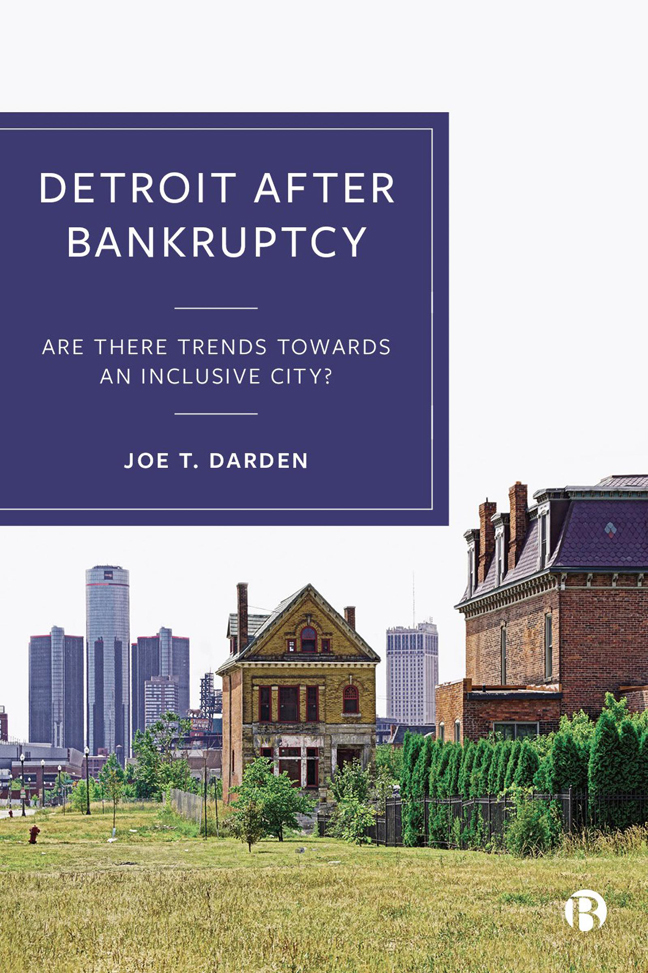Book contents
- Frontmatter
- Dedication
- Contents
- List of Figures and Tables
- Acknowledgments
- Preface
- 1 Antecedents to Bankruptcy
- 2 Detroit Bankruptcy: The Characteristics of the Decision Makers and the Differential Benefits Afterwards
- 3 The Postbankruptcy Social and Spatial Structure of Metropolitan Detroit: Anatomy of Class and Racial Residential Segregation
- 4 Gentrification: A New Method to Measure Where the Process Is Occurring by Neighborhood
- 5 The Uneven Distribution of Economic Redevelopment: Which Neighborhoods Are Excluded?
- 6 Black and Hispanic Underrepresentation in Business Ownership in a Majority-Black City
- 7 Racial Inequality in Student Academic Achievement Levels: A Neighborhood Solution to the Problem
- 8 Unequal Exposure to Crime in the City of Detroit: A New Method to Measure Exposure by the Characteristics of Neighborhoods
- 9 Solving the Problem of Extreme Race and Class Inequality: Implementing the Spatial Mobility Alternative
- 10 Conclusions: The Status of the Residents of Detroit after Bankruptcy
- References
- Index
2 - Detroit Bankruptcy: The Characteristics of the Decision Makers and the Differential Benefits Afterwards
Published online by Cambridge University Press: 25 January 2024
- Frontmatter
- Dedication
- Contents
- List of Figures and Tables
- Acknowledgments
- Preface
- 1 Antecedents to Bankruptcy
- 2 Detroit Bankruptcy: The Characteristics of the Decision Makers and the Differential Benefits Afterwards
- 3 The Postbankruptcy Social and Spatial Structure of Metropolitan Detroit: Anatomy of Class and Racial Residential Segregation
- 4 Gentrification: A New Method to Measure Where the Process Is Occurring by Neighborhood
- 5 The Uneven Distribution of Economic Redevelopment: Which Neighborhoods Are Excluded?
- 6 Black and Hispanic Underrepresentation in Business Ownership in a Majority-Black City
- 7 Racial Inequality in Student Academic Achievement Levels: A Neighborhood Solution to the Problem
- 8 Unequal Exposure to Crime in the City of Detroit: A New Method to Measure Exposure by the Characteristics of Neighborhoods
- 9 Solving the Problem of Extreme Race and Class Inequality: Implementing the Spatial Mobility Alternative
- 10 Conclusions: The Status of the Residents of Detroit after Bankruptcy
- References
- Index
Summary
Introduction
On July 18, 2013, Detroit filed for the largest municipal bankruptcy in US history. The city emerged 17 months later with a Plan of Adjustment. This chapter examines: (1) the legal origin of the city's bankruptcy; (2) the summary of oral opinion and reasons why the decision was made for bankruptcy by Judge Steven Rhodes; (3) the characteristics of the decision makers; and (4) the characteristics of the creditors and of winners and losers resulting from the Plan of Adjustment. This chapter is based on a critical examination of the bankruptcy decision, and a Plan of Adjustment that was the resolution. It focuses on the decision makers after discussing that the State of Michigan did not provide full revenue sharing. The most important decision maker was Emergency Manager Kevyn Orr, who wrote the Proposal to Creditors in 2013. Kevyn Orr was born May 11, 1958, in Fort Lauderdale, Florida. He received his law degree from the University of Michigan in 1983 and worked as an Assistant General Counsel for complex litigation and bankruptcy. In 1995 he was the Deputy Director of the Executive Office for United States Trustees, a division of the US Department of Justice that monitors the nation's bankruptcy system (Davey, 2013). In 2001, he was hired by Jones Day International Law firm as a partner, where he advised Chrysler on its bankruptcy. He was also honored as a Fellow of the American College of Bankruptcy.
The Proposal to Creditors document was among the most important documents to use for the chapter. It was relied upon in detail for this chapter. After meeting with 150 invited representatives, Emergency Manager Kevyn Orr wrote that Detroit be authorized to file for relief under Chapter IX of the Bankruptcy Code. The Plan of Adjustment process set forth in the Bankruptcy Code created a mechanism by which Detroit may bind all of its creditors even if all creditors did not assent to the city's restructuring plan (Orr, 2013a: 10).
The case was then turned over to Judge Steven Rhodes and the other key decision makers for their views.
- Type
- Chapter
- Information
- Detroit after BankruptcyAre There Trends towards an Inclusive City?, pp. 18 - 34Publisher: Bristol University PressPrint publication year: 2023

